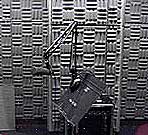|
 Many studios built in the 1970's were designed NOT to have
any acoustic influence on the recorded sound produced in them.
This was accomplished by over-deadening walls, floors and
ceilings so no sound waves (leakage) would reflect and add
(or subtract) from the instrument's original sound waves.
Bass traps were purpose-built for controlling sound from
electric bass amps, small isolated (and dead sounding) drum
booths were mandatory and heavy gobos or baffles were used
around all musicians separating them and their instrument's
sound. Many studios built in the 1970's were designed NOT to have
any acoustic influence on the recorded sound produced in them.
This was accomplished by over-deadening walls, floors and
ceilings so no sound waves (leakage) would reflect and add
(or subtract) from the instrument's original sound waves.
Bass traps were purpose-built for controlling sound from
electric bass amps, small isolated (and dead sounding) drum
booths were mandatory and heavy gobos or baffles were used
around all musicians separating them and their instrument's
sound.
Even before 16-track tape recorders became standard, engineers
and producers were overly concerned with maximum separation of each
instrument for ultimate mixing control.
I can remember throwing extra rugs on the floor, laying moving blankets
on top of pianos, and using a beach umbrella over the drum kit to
contain and control sound emanation. After a few years of this approach,
some musicians began to complain that they couldn't hear themselves,
and more importantly, couldn’t hear the other musicians.
Their instruments didn’t sound or feel right in these dead
spaces. Any time I happen to record in older rooms, built before
the '70's dead zone era, musicians are much happier, especially
brass sections and drummers.
I had occasion to record a brass session recently in a private-use
studio that was built in the '70's, and I was immediately confronted
with a disgruntled group of horn players very upset to be stuck
playing there. The producer and I wanted good performances from
these guys, yet all we initially heard was complaining about the
room and the poor sound of their horns.
I needed to liven the room up now! Short of ripping up all the wall-to-wall
carpeting and pulling down all the acoustic treatments, what could
I do?
Horn players usually wear single-sided headphones so they can hear
the track in one ear and pitch their instrument, blend and hear
one another with the other ear. So just putting reverb in the phones
is no good; they'll just tell me to take it off so they can hear
the track's rhythm better. (These phones have to be loud; try standing
next to a trumpet player who's really blowing!)
That's when it hit me. What if I create a bigger sounding room by
adding ambience to the room itself rather than with a cheesy effect
to the recording?
I took a mix of the horn mics using an aux send from the microphone
input faders and sent it to a digital reverb. I think it was a Lexicon
PCM 90 set to large room. I patched the PCM 90's 100-percent “wet”
output directly to the power amplifier feeding the studio speakers
out in the room where the players were. I kept the 25ms of pre-delay
in the preset to represent about 25 feet of distance to my "imaginary"
room's nearest wall.
While the players were warming up and rehearsing the chart, I slowly
brought up the level to the speakers until someone noticed. (Obviously,
you can't use a lot of this or you'll feed back) At first the leader
of section said: "what the hell is that?" When he figured
it out, he asked for more of it! We started overdubbing and when
I solo'd the horns, I could hear a little of that "enhanced
room" also getting recorded; it sounded great.
The players were all smiling and playing their butts off. Hearing
that added ambience in the same room as the rest of the section
gave each of them the feeling of playing in a livelier, bigger room.
We got better performances, good sound and less hassle.
|